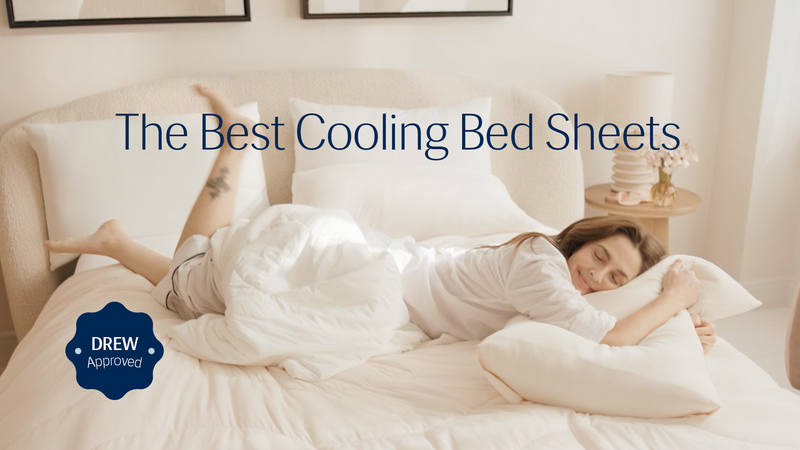Best Fabric for Hot Sleepers: Top Breathable and Cooling Materials Compared
If you’re waking up sweaty more often than not, your sheets might be part of the problem. A lot of bedding is made to look good or feel cozy first, but it does not always help with cooling. When your body tries to let off heat during the night, some fabrics just hold onto that warmth and moisture, which makes it harder to sleep comfortably.
Your body naturally cools down while you sleep by pushing heat out toward the surface of your skin. But if your sheets are not breathable, that heat gets trapped right next to you. That is usually when the sweating kicks in, and it can lead to more tossing and turning through the night.
Sheets made with breathable, moisture-wicking fabrics let your body do what it is supposed to do. They help with airflow, move sweat away from your skin, and let you settle into a deeper, cooler sleep.
Top Sheet Fabrics for Hot Sleepers
1. Breathable Linen Fabric
Linen is one of those fabrics that just works well when the weather’s warm. It lets air move through without holding onto heat, which helps if you’re someone who gets hot at night. It also pulls moisture away from your skin, so you’re not left feeling damp or sticky. What’s nice is that it softens up the more you use it, and you do not have to baby it in the wash. It also happens to be naturally antibacterial, which is a bonus.
2. Smooth, Cooling Silk
Silk feels cool the second you touch it, and it has this natural way of adjusting to your body temperature. If you run warm, it helps keep things comfortable without clinging or trapping heat. It is definitely more delicate when it comes to care, but if you like the idea of sheets that feel light and a bit more refined, silk is worth a look.
3. Soft and Durable Bamboo
Bamboo sheets are soft in a way that feels clean and cool at the same time. They breathe easily and help pull heat and sweat away from your body, which makes them great in humid places or if you tend to wake up feeling too warm. They also hold up well after a lot of use. They do not wrinkle too much, and they feel smooth without being clingy or slick.
4. Classic Cotton with Percale Weave
Percale-woven cotton has that crisp, matte feel that stays cool when other sheets start to feel heavy. It lets air move through better than something like sateen, which can feel thick and warm by comparison. Organic cotton is a plus if your skin reacts to dyes or finishes. Just avoid going too high with the thread count. That usually makes the fabric tighter, and tighter means hotter.
5. Eco-Friendly Tencel from Eucalyptus
Tencel has a smooth feel that stays cool without trying too hard. It handles sweat quietly in the background and never really feels damp. It is one of those fabrics that just works without needing much thought. Since it is made from eucalyptus, it is also easier on the environment if that matters to you.
Rest: Cooling Fabric Technology Designed for Hot Sleepers

If you tend to run hot at night, Rest’s sheets offer something a little different from the usual cooling fabrics. Instead of cotton or bamboo, they use a blend of nylon and spandex that feels cool the moment you get into bed. What sets them apart even more is the IONIC+ silver yarn woven into the fabric, which helps keep things fresh by slowing down odor buildup.
They pull heat away from your body quickly and help prevent that sticky, sweaty feeling that can make it hard to fall asleep. The texture is smooth without being clingy, and the cool feel lasts throughout the night.
What you can expect:
-
Temperature control that kicks in right away
-
Fabric that stays cool and dry, even in warm weather
-
Less odor, thanks to the silver yarn
-
A fit that stretches slightly and holds up well over time
If you are looking for something beyond natural fibers and want sheets that feel cool straight out of the package, Rest’s Evercool fabric is worth a closer look.
Other Bedding Pieces That Can Help You Sleep Cooler
Mattress Topper Solutions for Heat Reduction
If your mattress holds onto warmth, it can make it hard to stay comfortable. A cooling topper can help with that. Something made from latex or gel-infused foam tends to breathe better and lets air move around, so you are not stuck in one hot spot all night. Some even come with extra cooling features built in, but even a simple one can take the edge off.
Lightweight and Airy Comforters

A thick comforter might feel nice at first, but it can easily become too much. If you sleep warm, it is better to go with something lighter. Bamboo, cotton, silk, or synthetic down alternatives are all decent options. Cooling comforters are not as heavy and usually allow for better airflow, which helps you avoid that weighed-down, overheated feeling.
Sleep Pillows Supporting Temperature Control
Pillows can hold a surprising amount of heat, especially the dense ones. Gel foam or natural-fill pillows tend to stay a bit cooler and breathe better. The goal is just to keep your head from getting too warm, so you are not flipping your pillow in the middle of the night trying to find the cool side.
Practical Tips for Hot Sleepers
If you tend to overheat at night, small changes can help.
-
Go with bedding that feels light and allows air to move. Sheets made from breathable fabric make it easier to stay comfortable, especially when it is warm.
-
Wash them often to keep them fresh, since clean sheets do a better job pulling moisture away from your skin.
-
Try to keep your room cool too, whether that means using a fan, opening a window, or running the AC.
-
Instead of one heavy blanket, use a few lighter layers that you can adjust as needed.
How to Care for Your Cooling Sheets
Cooling sheets are only as good as how you care for them. Always wash them in cold water using a gentle liquid detergent. Skip anything with enzymes or brighteners since those can wear down the fibers that help with breathability. Powder detergents tend to leave residue that can block airflow, so they are best avoided.
Fabric softeners might seem helpful, but they can actually make the sheets worse at managing heat and moisture. For bamboo, Tencel, or microfiber, stick with a gentle cycle. Cotton percale and linen are a bit sturdier but still do better with cold water. When it is time to dry, go for low heat or hang them up if possible. High heat can cause shrinking and break down the material that keeps the sheets feeling cool.
|
Dos |
Don'ts |
|
Wash in cold water |
Use hot water |
|
Choose a gentle liquid detergent |
Use powder detergent |
|
Avoid fabric softeners |
Use fabric softeners |
|
Dry on low heat or air-dry |
Dry on high heat |
When to Know It’s Time for New Cooling Sheets
Cooling sheets are not built to last forever. After a while, they just do not work the same. If they start feeling stuffy, take longer to dry when you sweat, or lose that light, breathable feel, that is usually a sign they are wearing out.
Most cooling sheets hold up for a few hundred washes, somewhere around 300 to 500, depending on how you care for them. That usually means two to four years of steady use. If yours are starting to feel off, it might be time to swap them out so you can keep your bed cool.
Frequently Asked Questions (FAQ)
1. Do cooling sheets actually work in humid weather?
Yes, they can. In humid conditions, the right sheets can still make a noticeable difference. Fabrics like bamboo and Tencel are good at pulling moisture off your skin and drying quickly, which helps cut down that damp, sticky feeling. Some microfiber blends work too, as long as they are designed to breathe. Cotton or linen might feel fresh at first, but in really humid air, they do not always keep up the same way.
2. What is the difference between cooling sheets and moisture-wicking sheets?
Cooling sheets are all about airflow and helping your body stay at a comfortable temperature. Moisture-wicking sheets focus more on pulling sweat off your skin and drying fast. The best ones manage to do both, so you stay dry and cool without feeling like your sheets are holding onto the heat or moisture. Bamboo is one fabric that tends to do both pretty well without needing any extra treatments.
3. Will cooling sheets stay cold while I sleep?
Not really. Most cooling sheets are not meant to feel cold all night. What they do well is help move heat away from your body so you do not overheat. Some use special materials that hold onto a cooler feel a little longer, but even those will level out after a while. The goal is not to keep you cold, just to keep things from getting too warm.
4. Can I use cooling sheets outside of summer?
Yes, for sure. Cooling sheets can work all year. Materials like bamboo and Tencel adjust to your body temperature, so they still feel good when it is cooler out. If your sheets are really lightweight or loosely woven, you might want to add an extra blanket when it gets cold, but in most cases, you can use them through every season without a problem.







